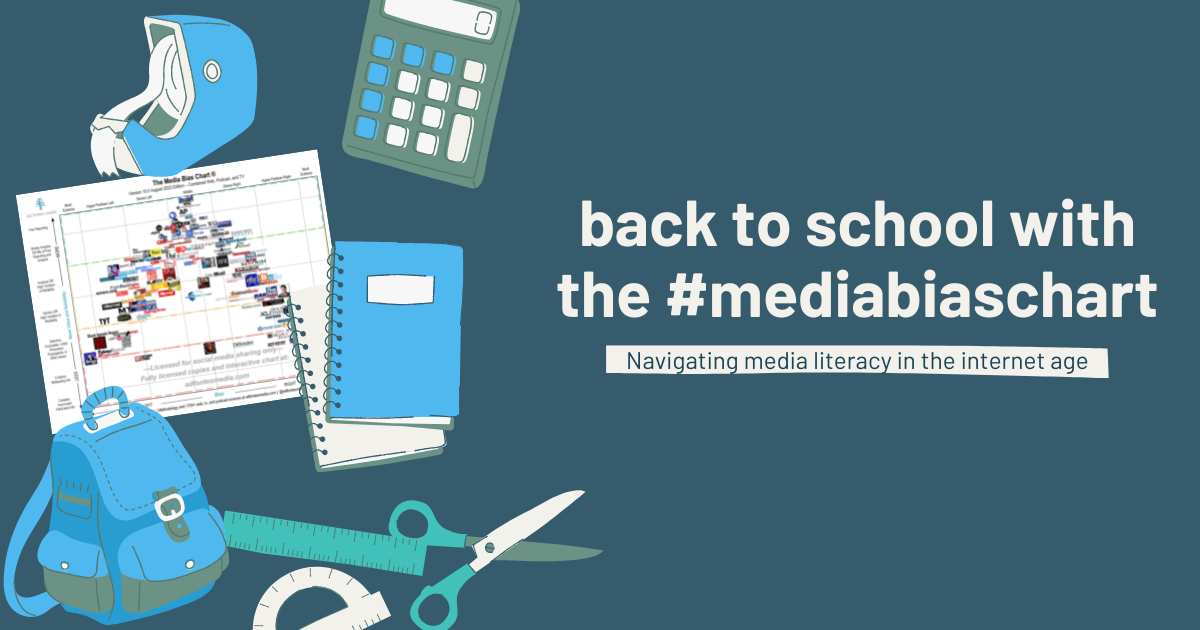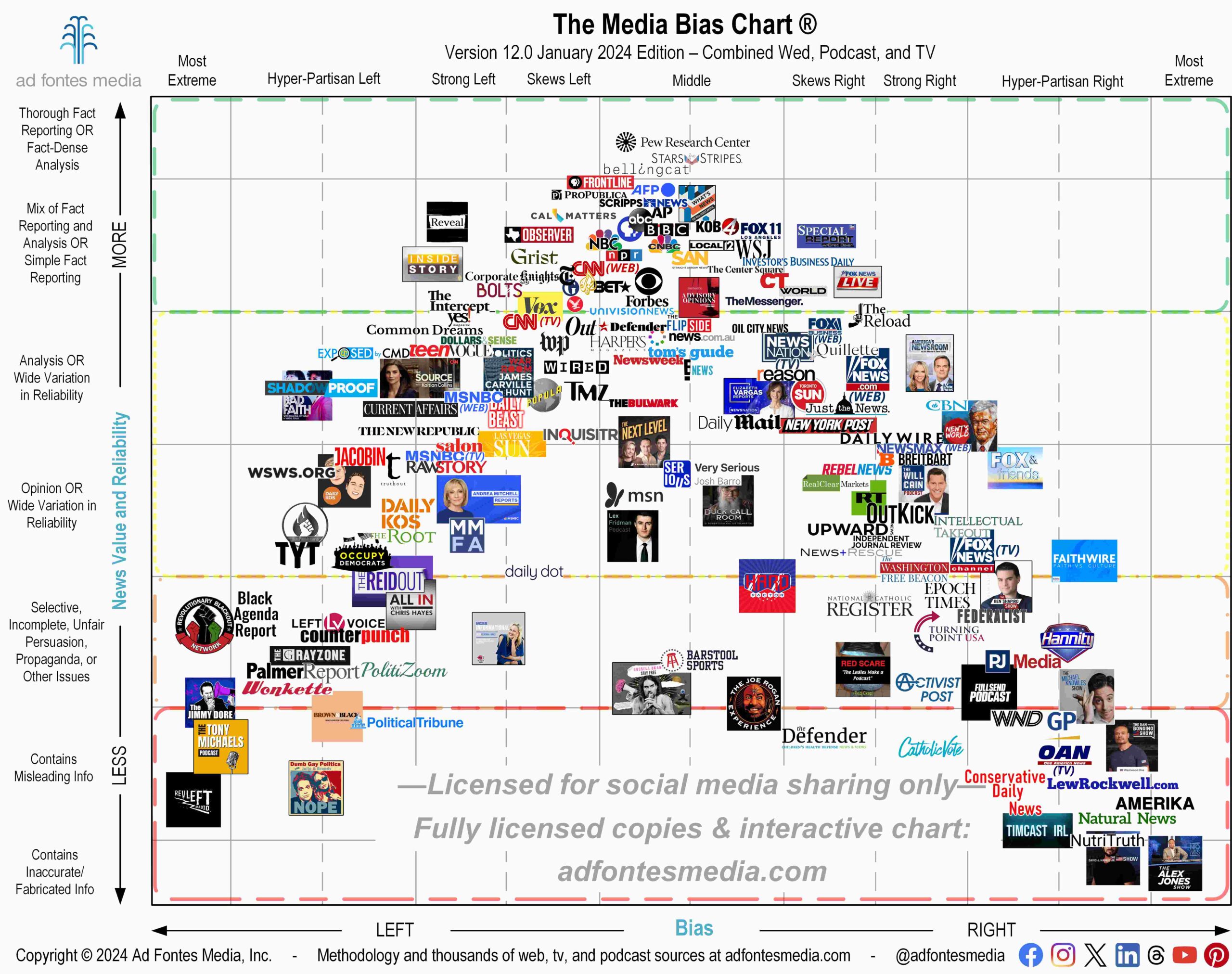Menu

Back to School with the Media Bias Chart
Author:
Sara Webb
Date:
09/19/2022
The amount of supplies that my kid needed to bring to her first day of second grade was extensive. We had managed to find a cute pair of kitty earbuds, a nice selection of mermaid pencils – anything to distract her from the loss of that delicious freedom she enjoyed over the summer. Now we’re back to bedtimes and routines. Great for parents, slightly depressing for kids.
As I watched her make a slow way into school with a backpack packed full of supplies, I took a minute to tamp down the fact that she was headed into a school building (shootings, COVID, bullying) and think about all of the things that she would get out of school this year. For parents, this is not an easy practice.
I am grateful that my kid has a teacher this year, because this is not the case everywhere in the U.S. I’m happy that she’s in a building that takes safety seriously, that she’s not in the same class as that girl she kept getting in trouble for talking to all last year, and that we sprung for the new Harry Potter backpack because it looks pretty fly.
We looked over her schedule last night, and it was pretty standard: language arts, math, science, social studies, art, P.E., library, STEM, and music. I am a fifteen year veteran of a high school library, and while I wish my job had been just sitting there reading books all day, my duties covered everything from curating our online resources to teaching internet safety, and I am left wondering when those skills will enter her vocabulary
CRITICAL THINKING & MEDIA LITERACY
For most of the folks reading this, I’m willing to bet that the internet appeared in your lifetime. We are digital immigrants: we remember getting dial-up internet at home, and we learned how to do PowerPoint presentations in college. Online everything bubbled up and then exploded and then came back around, and now it seems like life cannot continue without it. The kids in school right now are digital natives: they have grown up with parents ordering pizza on their phones or making video calls from wherever we happen to be in space and time. This is a Star Trek reality we’re living in, and if you take a moment to think about it, we learned critical thinking skills, and then we learned the internet. There was a clear progression (even if some of us seem to have stopped applying those skills).
My kid is going to be learning critical thinking skills and how to use the internet at the same time. How does that work? I really don’t know. It’s not on her schedule, and from my own school experience, it’s a heavy lift. Most students know how to use the internet before they develop critical thinking skills, which means that ordering an Uber to take you to Starbucks before sports practice is much more normal than truncating a URL to see if a website is legit
If there’s a step up in this battle, then my daughter’s going to have it. I’ve been in the school system for awhile and I’ve taught years of media literacy classes. I can explain lateral reading and show you how to do it. I know what clickbait is and which words are meant to drive you to a website where clicks are just a way to make money.
How do you get from second grade to internet critical thinker? There are a few ways, this is true, but as with her state-approved Language Arts curriculum, having a path for learning is the most efficient way to internalize a new skill – and this is an important one. As the last few election cycles have proven, this might be the most important skill of all right now.
THE MEDIA BIAS CHART
I first stumbled over the Media Bias Chart years ago when I was developing the curriculum for my freshman year media literacy class. It was awesome. It was a visual tour of bias and reliability on the internet. When I showed it to my students that year I could actually see the neurons firing in their teenage brains. It was glorious.
The next year, there was a new chart. And then there were educational materials, and that is the next phase of this story. There is a way to read a page on the internet and determine whether it is trying to fleece you or be truthful – if it is leaving out important details from a story or if it glosses over key facts. I learned these skills and I taught them to the teens in my classes. I watched them develop the level of critical thinking that I want my kid to learn. It’s not easy, especially since our personal convictions can make it a lot easier to keep believing and thinking a certain way, but this is the work that is ultimately going to help us understand opposing viewpoints and avoid dabbling in conspiratorial thinking. Learning these skills will make the internet a safer and more rational place, for digital immigrants and digital natives alike.
If you want to learn more, visit us at adfontesmedia.com. Marvel at our Media Bias Chart, do a few searches on our Interactive version to find where your news sources lie, and then start exploring how you can learn to be a critical thinker and a lateral reader. All of those digital natives are depending on us, mine included.
Sara Webb
Sara Webb is a cybersecurity consultant and former high school librarian from Philadelphia, PA. She holds an M.S. in Informatics and an M. Ed in School Library and Information Technology, and has been a media literacy educator for over a decade. Sara started with Ad Fontes Media in July 2020 as a Media Analyst, and she currently continues in that role and as in-house Media Literacy Specialist. When not engrossed in media literacy projects, Sara can be found at the barn with her ex-racehorse Homer, or training her corgis for dog agility competitions.


